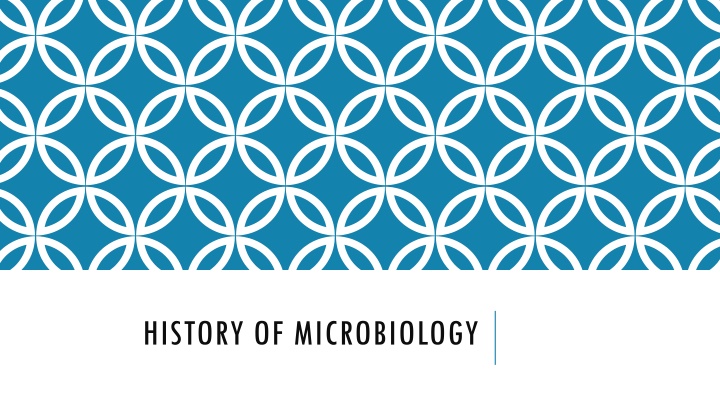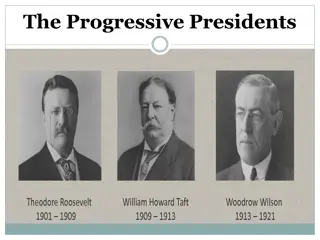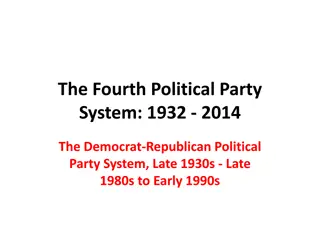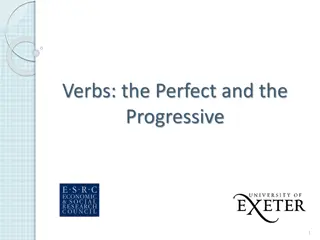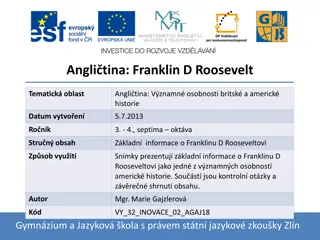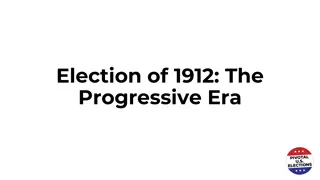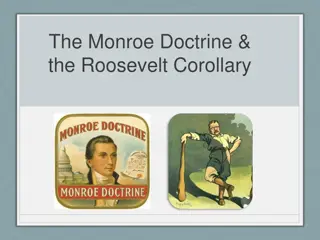Teddy Roosevelt: The Progressive Era
Teddy Roosevelt, a key figure in the Progressive Era, made significant strides in reforming business practices, advocating for women's suffrage, and championing conservation efforts. His presidency brought about important legislative changes and his influence resonated deeply in American politics during the early 20th century.
Download Presentation

Please find below an Image/Link to download the presentation.
The content on the website is provided AS IS for your information and personal use only. It may not be sold, licensed, or shared on other websites without obtaining consent from the author.If you encounter any issues during the download, it is possible that the publisher has removed the file from their server.
You are allowed to download the files provided on this website for personal or commercial use, subject to the condition that they are used lawfully. All files are the property of their respective owners.
The content on the website is provided AS IS for your information and personal use only. It may not be sold, licensed, or shared on other websites without obtaining consent from the author.
E N D
Presentation Transcript
MUMMIES HAVE BACTERIA! The science of microbiology dates back only 200 years, yet the recent discovery of Mycobacterium tuberculosis DNA in 3000-year-old Egyptian mummies reminds us that microorganisms have been around for much longer. In fact, bacterial ancestors were the first living cells to appear on Earth.
THE FIRST OBSERVATIONS After observing a thin slice of cork, an Englishman, Robert Hooke, reported to the world that life's smallest structural units were "little boxes," or "cells," as he called them. Using his improved version of a compound microscope (one that uses two sets of lenses), Hooke was able to see individual cells. Hooke's discovery marked the beginning of the cell theory, the theory that all living things are composed of cells.
THE DUTCHMERCHANT! The Dutch merchant and amateur scientist Anton van Leeuwenhoek was probably the first actually to observe live microorganisms through the magnifying lenses of more than 250 microscopes he constructed. Between 1673 and 1723, he wrote a series of letters to the Royal Society of London describing the "animalcules" he saw through his simple, single-lens microscope.
GERM THEORY OF DISEASE Microorganisms might have strong relationships to create diseases of plants and animals. This idea was known as the germ theory of disease. Microorganisms that cause disease are called pathogens, and the diseases they cause are called infectious diseases. The germ theory was proposed in the mid-16th century and gained widespread credence when substantiated by scientific discoveries of the 17th through the late 19th century.
KOCHS DISCOVERY OF ANTHRAX Robert Koch (1843 1910) : Discovered the typical bacilli having squarish ends in the blood sample of cattle that had died due to anthrax. The founder of modern bacteriology, he is known for his role in identifying the specific causative agents of tuberculosis, cholera, and anthrax and for giving experimental support for the concept of infectious disease.
KOCHS EXPERIMENT First of all these bacteria were grown in cultures in the laboratory Bacteria examined microscopically to confirm only one specific type was present Injected bacteria into other animals to observe whether they got also infected, and subsequently developed clinical symptoms of anthrax Isolated microbes from experimentally infected animals Compare the microorganism from experimentally infected animals with those obtained originally from sheep that died due to anthrax
KOCHS POSTULATES A particular microbe (organism) may invariably be found in association with a given disease The organism may be isolated and cultivated in pure culture in the laboratory The pure culture shall be able to cause the disease after being properly inoculated into a susceptible animal It should be quite possible to recover the causative organism in its pure culture from the infected experimental animal.
SPONTANEOUS GENERATION Until the second half of the nineteenth century, many scientists and philosophers believed that some forms of life could arise spontaneously from nonliving things; they called this hypothetical process spontaneous generation. Not much more than 100 years ago, people commonly believed that toads, snakes, and mice could be born of moist soil. Spontaneous generation refers to the speculated processes in which different types of life might repeatedly emerge from specific sources other than seeds, eggs or parents.
PASTEUR'S EXPERIMENT DISPROVING THE THEORY OF SPONTANEOUS GENERATION 1. Pasteur first poured beef broth Into a long-necked (goose- neck) flask 2. Next he heated the neck of the flask and bent it into an S- shaped curve; then he boiled the broth for several minutes 3. Microorganisms did not appear in the cooled solution, even after long periods 4. Pasteur's unique design allowed air to pass into the flask, but the curved neck trapped any airborne microorganisms that might contaminate the broth 5. Pasteur showed that microorganisms can be present in nonliving matter-on solids, in liquids, and in the air
After this experiment Pasteur postulated that There is no known circumstance in which it can be confirmed that microscopic beings came into the world without germs, without parents similar to themselves.
BIOGENESIS 1.The claim that living cells can arise only from preexisting living cells. 2.Arguments about spontaneous generation continued until 1861, after that the issue was resolved by the French scientist Louis Pasteur. 3.Biogenesis is the production of new living organisms or organelles. The law of biogenesis, ascribed to Louis Pasteur, is the observation that living things come only from other living things, by reproduction. That is, life does not arise from non-living material, which was the position held by spontaneous generation.
PURE CULTURE Pure culture may be defined as the propagation of microorganisms or of living tissue cells in special media that are conducive to their growth. In other words it may also be explained as the growth of mass of cells belonging to the same species in a laboratory vessel (e.g., a test tube). It was indeed Joseph Lister, in 1878, who first and foremost could lay hand on pure cultures of bacteria by the aid of serial dilution technique in liquid media.
IMPORTANCE OF PURE CULTURE 1. By using pure culture technique the microorganisms causing a large number of infections, certain specific fermentative procedures, nitrogen- fixation in soil, high-yielding alcohol producing strains from malt wort , and molasses can be isolated and identified 2. It also helps to select good cultures for making top-quality products such as wines 3. Made possible to identify specific cultures for manufacturing dairy products e.g. cheeses, yogurt. 4. Pave the way of better understanding of the physiology of individual microorganisms present in the pure culture 5. Understanding the ecological relationships of the entire microbial populations in a given environment
METHODS OF PURE CULTURE Serial dilution: Lister diluted milk, comprising of a mixture of bacteria, with a specially designed syringe until a single organism was strategically delivered into a container of sterile milk. The container on being subjected to incubation for a definite period gave rise to a bacteria of a single type, very much akin to the parent cell. Lister termed it as Bacterium lactis.
Colonies : Koch smeared bacteria on a sterile glass slide, followed by addition of certain specific dyes so as to observe the individual cells more vividly under a microscope . Then he carefully incorporated some specific solidifying agents, such as : gelatin, agar into the media in order to obtain characteristic isolated growths of organisms usually called as colonies. Importantly, each colony is essentially comprised of millions of individual bacterial cells packed tightly together.
Virulence : Virulence is the degree of pathogenicity within a group or species of parasites as indicated by case fatality rates and/or the ability of the organism to invade the tissues of the host.
Attenuated microorganism: Attenuated microorganism is a solution which is saturated with killed organisms to be administered in the human blood via injection to act as a vaccine.
Protection against Infection:Immunity Pasteur has made use of the fundamental techniques devised by more theoretical Koch. Pasteur has successfully proved though experiment the causative organism responsible for Cholera. He inoculated healthy chickens with his pure cultures but surprisingly found that chickens failed to get sick and die. By reviewing each step of the experiment, Pasteur found that he has accidentally used cultures several weeks old instead of fresh ones. Pasteur then repeat the experiment and took two groups of chickens. One of these groups had been inoculated at the first demonstration with the old cultures that had proved ineffective, and the second had not been previously exposed. Both groups received bacteria from fresh young cultures. This time the chickens in the second group got sick and died but those in the first group remained hale and hearty.
Protection against Infection:Immunity Pasteur has explained the situaton: In some way bacteria could lose their ability to produce disease, i.e., their virulence, after standing and growing old. But these attenuated (having decreased virulence) bacteria still retained their capacity for stimulating the host to produce substances, i.e., antibodies, that protect against subsequent exposure to virulent organisms.
Protection against Infection:Immunity Pasteur has discovered vaccine for hydrophobia or rabies, a disease transmitted to people by bites of dogs, cats, and other animals. It has been established that the rabies virus was too minute to be seen even with a microscope; it had never been grown in laboratory culture, and it was not a bacterium. The disease can be produced from rabies by inoculating them with with saliva from a rabid mad dog. Then the brain and spinal cord could be removed from the infected rabbitsVirus in the extract of the rabbit s spinal cord is attenuated before injection into a patient.
